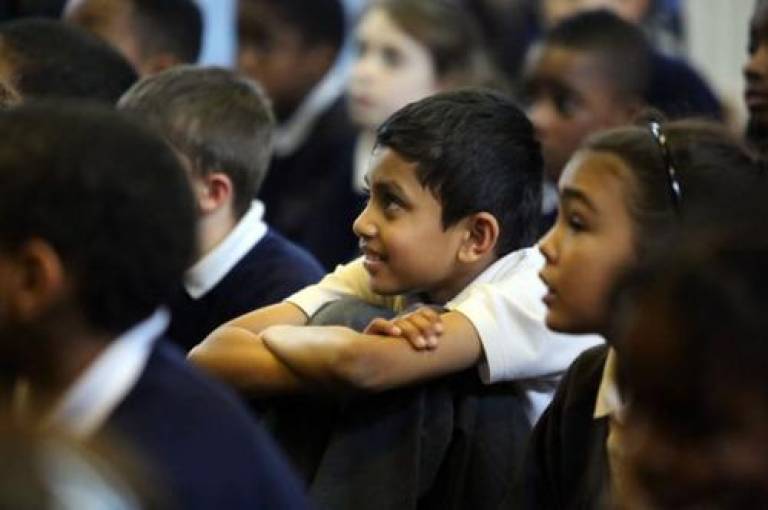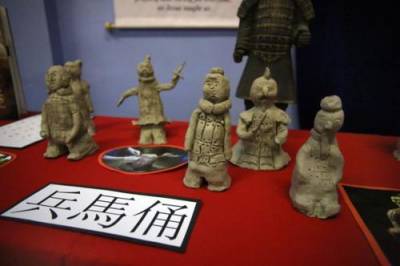Do archaeologists always carry two toothbrushes?
27 May 2014
You can never prepare well enough for an encounter with schoolchildren.
 They will always manage to catch you off-guard. A few
weeks ago I had great fun, and some moments of nerves, talking about
archaeology and archaeologists with some 350 children aged 7 to 11 at St.
Augustine's Catholic Primary School.
They will always manage to catch you off-guard. A few
weeks ago I had great fun, and some moments of nerves, talking about
archaeology and archaeologists with some 350 children aged 7 to 11 at St.
Augustine's Catholic Primary School. Some children eager to find out more about the Terracotta Army (courtesy of Elinor Hoskins, Archant).
It was hard for me to focus on what I was saying, mesmerised as I was to see them all sitting on the floor of their assembly room, wide-eyed, quiet and expectant. Everything had been arranged by Bruna Ranjan, the school's inclusion manager, who puts together an excellent programme of visitors who talk about their experiences in different world regions (you can see pictures of this and other events on the school's website, under 'Gallery').
Only as I arrived at the school did I discover that their teachers had organised a range of activities around China and the Terracotta Army in the week leading up to my visit. So all the trivia I had prepared for my presentations (how many, how old, how big…) was old news for them! Some of the older children had even had a go at making their own terracotta warriors, which no doubt rival the real ones in beauty and might.

These warriors would not feel out of place in Xi'an (courtesy of Elinor Hoskins, Archant).
With my plans out of the window, I decided to let the children take the lead by asking whichever questions they had. Here are some of the most difficult ones:
- Do you get to travel to all of these places for free?
- But what happens if a warrior is trying to kill an enemy with his halberd but then the enemy dodges? (here I found myself carried away explaining that another warrior could try to surprise the enemy with his sword from behind as he dodged… of course I justified this as an example of the virtues of working as a team)
- Why did you decide to become an archaeologist? (you'd think that's an easy one to answer, but think again: they don't know who Indiana Jones is!)
- Do you get to keep what you find? (great cue to talk about heritage as a shared, non-renewable resource)
- So did the emperor live in the afterlife? (note this is a Catholic school - how do you answer this one without triggering a cascade of questions?)
- How much do you earn? (seriously!)
- Do you use your toothbrush for digging or you take another one just for digging?
- Why did the emperor get so many warriors of clay if everyone would know that they couldn't move?
The last question is one that actually deserves being discussed in detail (which I'm not attempting here!). The First Emperor's tomb marks a transition between earlier princely graves (where the human and animal entourage of the deceased were buried with him) and later ones (where the guards, horses and other figures buried with the important person are sculptures). For example, in Xi'an there are both terracotta horses and real horses that show evidence of having been buried alive. If the expectation of those taking families and servants to their grave was that they would join them as living creatures in the afterlife - surely something similar must have been expected of the artificial warriors, acrobats, horses and birds? The practice of replacing real people and animals with representations was much more sustainable, but I suppose religious beliefs must have evolved to allow for this ritual change without compromising the safe and enjoyable afterlife of the Emperor.
We keep trying to make sure that our work, and that our many colleagues in China, is reaching and hopefully inspiring more audiences. Without a doubt, this is one of the most rewarding jobs (as well as a duty) of those of us who work with public heritage. "Active engagement beyond academic circles" is one of our stated project aims, and this aim is materialising in various forms. The recent film on the New Secrets of the Terracotta Warriors (broadcast in the UK, but coming to other countries soon), has been watched by millions, and many of the team members keep giving talks to all kinds of audiences, and responding to as many requests as we can. Also recently, an article has appeared in Education in Chemistry that focuses on the role of chemistry and chemical analyses in our project. The article, written by Simon Rees, developed out of a presentation I gave last summer at the Gordon Research Conference on Chemistry Education, where I tried to argue that archaeological sciences could provide an alternative pathway to introduce school children to hard sciences. The talk was very well received then by the (mostly) science teachers attending. And as I finish typing these lines, Janice Li emails me to say that our recent paper on the triggers is reported on the Museum's website, where it should get a few more readers among the Chinese public. We are very glad to see our work reaching beyond academic circles. If you have any relevant question or curiosity that you would like us to address in this blog, let us know.
Marcos Martinón-Torres is Professor of Archaeological Science at the UCL Institute of Archaeology and the Director of the Imperial Logistics Project.
 Close
Close

